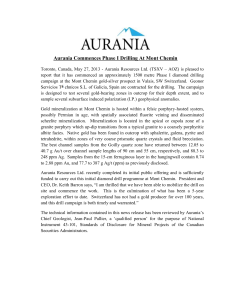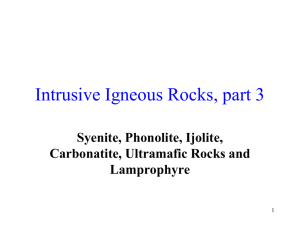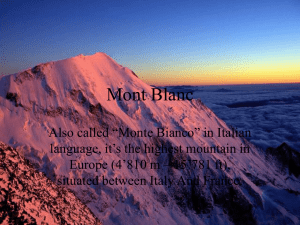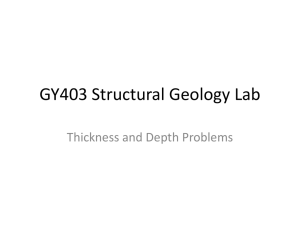2013 Igneous Petrology Field Trip * Francis
advertisement
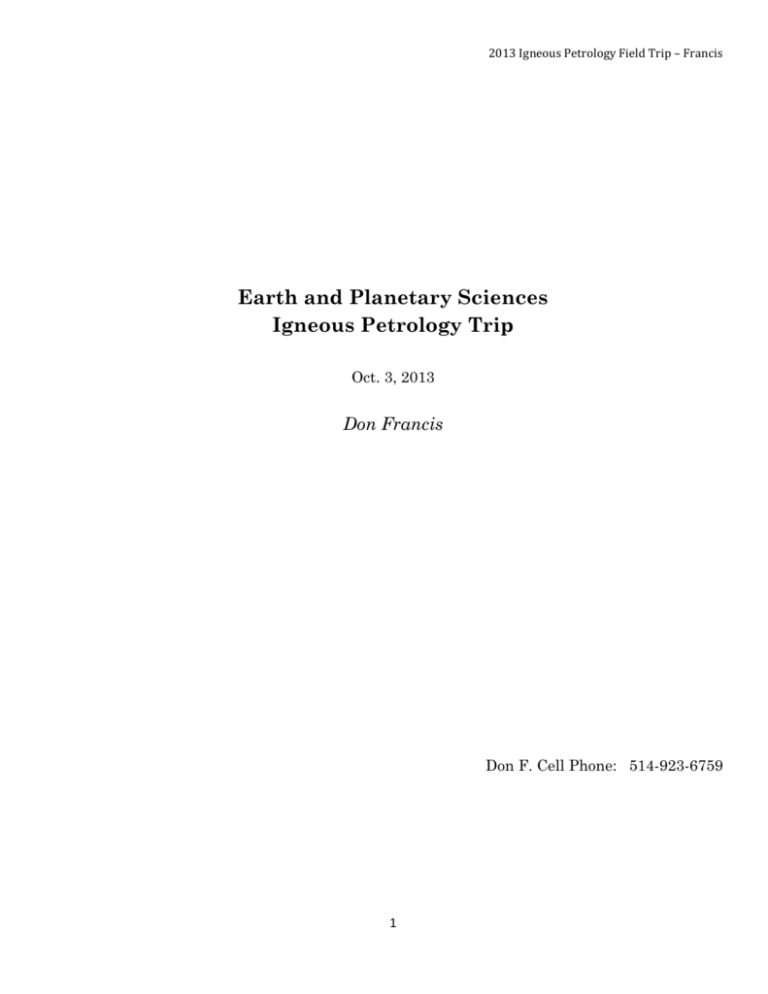
2013 Igneous Petrology Field Trip – Francis Earth and Planetary Sciences Igneous Petrology Trip Oct. 3, 2013 Don Francis Don F. Cell Phone: 514-923-6759 1 2013 Igneous Petrology Field Trip – Francis The Monteregian Hills Mont Brome Complex Stops B-1a, b, c: Slate to Gabbro Contact Begin by examining the outcrop of siltstone/slate just westof the intersection withn Chemin du Centre (a). This is the country rock surrounding the intrusion. Drive towards the East to the black outcrop on the North side of the road (b). What has changed? Drive further to the East, past the driveway to the beginning of large outcrop in the woods on the North side of the road (c). Begin looking for the contact with the gabbro of the intrusion by moving westward along this outcrop scarp (be careful of the garbage). What lines the contact between the gabbro and the country rock? Stop B-2: Gabbro Head North on Chemin Rogers. Examine the outcrops in the woods on the East side of the road past the crest of the ridge. Walk along the outcrops from North to South. What is the dominant lithology? Is there layering, and if so what defines it? Which way does the layering dip with respect to the Brome intrusion? Stop B-3: Syenite (pulaskite) Head North via Chemins Sanborn and then Miltimore to Chemin de Gaspé, continue North to Chemin de Missisquoi, take a right and then turn left at the top and drive to the large outcrop. The dominant outcrop is called pulaskite, what would you call it? Distinguish between the dark hornfels enclaves and the fine-grained mafic dyke in this outcrop. What is the honeybrown mineral? 2 2013 Igneous Petrology Field Trip – Francis Mont Brome Complex – cont. Stop B-4: Nepheline Syenite: Chemin Missisquoi: Enclaves of feldspathic hornblendite in nepheline syenite. Stops B-4, B-5, and B-6 are structurally higher than the syenite of stop B-3, note the greater abundance of dark enclaves. Stop B-5: Nepheline Syenite Chemin Irelandais / Shannon Stop B-6: Nepheline Syenite Chemin Irelandais / O’Connor Stop B-7: Nepheline Syenite (tinguiate) From the corner of Chemins de Gaspé and de Missisquoi, walk along the trail to the low outcrop ridge. This outcrop represents a small late-stage body of aegirine-bearing nepheline syenite (tinguaite). Examine the rock face in the hollow on the East side of the trail. How does this unit compare texturally to the lithologies of the last three stops? What is the significance of this difference? Stop B-8: Syenite (pulaskite) with dykes Head North on Chemin de Gaspé, take a right on Chemin de Chateauguay, and go to Chemin Champlain and the Ski Centre parking lot. Walk up the ditch along the road above the parking lot. This is another outcrop is the dominate felsic lithology of the Brome complex. Be on the alert for small cross-cutting dykes and enclaves (xenoliths). How many different dyke lithologies appear to be present? Stop B-9: Siltstone Hornfels 3 2013 Igneous Petrology Field Trip – Francis Mont Brome Complex 4 2013 Igneous Petrology Field Trip – Francis Take Chemin Champlain to return to autoroute #10 and head towards Montreal, exit route #227 for Mont. St. Gregoire. Drive ~ 5 km south and turn right towards the Mountain, follow the signs for the CIME centre at Mont St. Gregoire. Mont St. Gregoire Climb the Panorama trail to the summit of Mont St. Gregoire. Identify the mapped units along the way. In addition to basic lithology, characterize each map unit in terms of grainsize, presence or absence of layering, etc. Gather at the top for summary discussion. 5 2013 Igneous Petrology Field Trip – Francis Return to Autoroute #10 towards the West (Montreal), take route #134 North to the Jacques Cartier Bridge, take the exit to Ile St. Hélène on the Bridge, and stop at Museum parking lot under south access ramp. Ile St. Hélène Diatreme Breccia This stop is an exposure of the Ile St Hélène diatreme breccia pipe. A breccias pipe is a fragmental intrusive body that is approximately carrot or funnel shaped, opening as a cone towards the surface. It is thought to have been emplaced explosively as a solid–gas mixture and contains many accidental fragments of the surrounding host rocks. The characteristic feature that distinguishes diatreme breccias from other types of igneous breccias is that their matrix is clastic rather than magmatic. At depths, such pipes commonly grade into dykes of CO2-rich magmas, such as kimberlites, aillikites, or carbonatites. The present breccias are hosted by Ordovician Trenton Limestone and Utica Shale, but approximately 1km of overlying Paleozoic strata (~ 1km) has been lost through erosion since the diatreme’s emplacement, estimated by the recognition of Devonian brachiopods in some limestone fragments. Note the many different lithologies that are represented in the fragments at this location? 6
